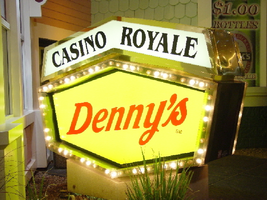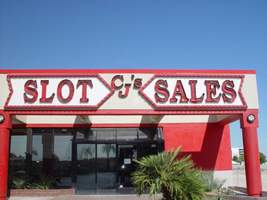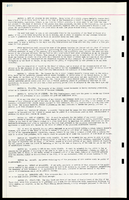Search the Special Collections and Archives Portal
Search Results

Photographs of Casino Royale and Denny's signs, Las Vegas (Nev.), 2002
Date
Archival Collection
Description
Site address: 3419 S Las Vegas Blvd
Sign owner: Tom Elardi
Sign details: The Casino Royale is located on the east side of the strip facing west, just south of the Venetian. The smaller establishment shares its space with a Denny's restaurant, which was present before the Royale was opened. The exterior is adorned with a stylized, European-esque, architecture, including apparent windows, domes, towers, and a cohesive landscape of connected buildings. The exterior of the Royale is a brightly lit facade of white raceways, lined with incandescent bulbs, boxing in vibrantly toned walls, and subdued neon. The colors correspond with those seen in the sign itself, as well the neon placed inside the edges of the windows. One section displays purple, the next a teal color, next a blue, then a red. Total signage of the property includes a two LED screens, one on the west side of the building, and the other housed in the logo cabinet on the south west corner of the property. Two logo cabinets, one in the aforementioned spot, and the second facing west over the main entrance on the west side of the building. Two double-faced cabinets lie on the northern end of the west side of the building, advertising for Denny's restaurant. Two small logos signs are also placed on the west face of the structure, for Caffe Trilussa.
Sign condition: Structure 5 Surface 5 Lighting 5
Sign form: Fascia
Sign-specific description: Upon the southwest corner of the building, a blue cabinet houses an LED screen in the rectangular body of the cabinet. The cabinet continues upward where the blue steel face supports white channel letters bordered in red neon and filled with incandescent bulbs. The text is written in two lines. The cabinet continues upward and is transformed into the sculpted design of a pink, purple, red, and blue crown on channel faced scrolls and sweeping shapes. The interiors of each section are lined with neon of a corresponding color to the paint treatments. Around to the west side of the building, the same style of text and scrolling adornments are used in a different marquee sign denoting the main entrance to the establishment. The same style of text seen on the southwestern sign is present with the same pattern of scroll work, crafted in a cabinet style, with channel faces. The major difference between the two signs is the size. The main entrance sign is much larger than the corner sign, as well as not having a LED screen incorporated below the text. The western sign possesses more scroll work below the text instead. The neon treatments are the same, as well as the incandescent bulbs, inside of the text. The lower roofline of the property plays host to the small but noticeable signage for Caffe Trilussa. Upon a extended surface of the roof line, two separate signs for the establishment are present. The roof shape is three sided with the signage on the northwest and southwest sides of the extension. Inside a section of the entablature created with white raceways, brown channel letters, spell the text "Trilussa," stretching across the length of the surface. The brown letters sit upon a yellow surface and are filled with incandescent bulbs, which are as wide as the channel letters themselves. Spelled in bent neon tubing, the word "Caffe" is spelled in all capital letters, sitting just above the left hand side of the title text. The right of the collection is occupied by a graphically treated, two-dimensional cut-out of a palm tree. The palm tree is treated on the surface with neon tubing as well. The tubing glows green and a gold corresponding to the graphical treatments. At the northern end of the property, two signs sit outside facing north, south. The double backed, internally lit cabinets represent the advertisements for the Denny's restaurant attached to the Royale. The first is at ground level outside the main entrance of the restaurant, the six sided, green cabinet, sports a yellow plastic face with red graphic text, reading "Denny's" in script text. Around the border of the face, incandescent bulbs run in a raceway pattern, and are covered in a plastic sheath. An angular cabinet rests on top of the other cabinet, creating a shallow peak. The internally lit, white face reads "Casino Royale" in black text. The same cabinet can be seen cantilevering off of the west side of the building above its partner sign. The cabinets are of identical design except for there is no plastic sheath covering the raceway of incandescent bulbs, and the plastic face of the main section of the cabinet is treated in different graphics. The script reads "Denny's" similar red script, but with a different background.
Sign - type of display: Neon; Incandescent; Backlit
Sign - media: Steel; Plastic
Sign - non-neon treatments: Graphics; Paint
Sign animation: Chasing, oscillating
Notes: The incandescent bulbs inside the channel letters of the main text oscillate, while all incandescent bulbs on the raceways along the building chase each other also. The incandescent bulbs, which surround the Denny's cabinet, also chase each other.
Sign environment: The Casino Royale stands independently on it's own even though it is surrounded on all sides by casino giants. To the north stands the Venetian, to the South stands Harrah's, and the Mirage lies west across the street. Yes, the property itself seems to be dwarfed by the immense neighbors, but the ultra bright, clear external signage and facade create a charming and bright environment that announces its presence.
Sign manufacturer: YESCO
Sign - date of installation: 1992
Sign - date of redesign/move: The Royale was once the Nob hill, which was closed in 1980. It was reopened in 1992 as the Casino Royale.
Sign - thematic influences: The theme seems to be tied to a European theme with the French term "Royale" in the title. The scrollwork is reminiscent of confetti or Mardi Gras theme. Such a combination of elements to suggest a theme is seen in the Harrah's property also. The party themed reminiscent sculpted cabinets are also reminiscent of the Fleur de Li. Believe it or not, the property is tied to many other larger, corporate, properties in one respect regarding its facades. The facade of a town or city, shrunken down and stylized into the facade of the property is present all over the Strip. Such properties which utilize this technique, to one degree or the next, include: New York New York, Oshea's, Treasure Island, Bellagio, The Venetian, The Luxor, The Tropicana, and the Excalibur.
Surveyor: Joshua Cannaday
Survey - date completed: 2002
Sign keywords: Chasing; Oscillating; Fascia; Neon; Incandescent; Backlit; Steel; Plastic
Mixed Content

Photographs of Arby's and Guinness World of Records Museum signs, Las Vegas (Nev.), 2002
Date
Archival Collection
Description
Site address: 2776 Las Vegas Blvd, 2780 Las Vegas Blvd
Sign owner: Arby's: Schultzen and Harry Sax, Guinness: ?, Cj's: PDS Gaming used to be Carl Fredrickson
Sign details: Located in a small lot on the west side of the strip, north of the giant Circus Circus pylon, and just north of the Arco AM/PM, the Arby's fast food establishment shares property and a sign with Guinness World of Records, and CJ's Slot Sales Facility. The Arby's is located in the front of the lot facing the strip, flanked on either side by drives. The "L" shaped structure for the other two establishments lies in the rear, western portion of the lot. To the north of the property, is vacant desert, stretching to Sahara Ave. To the south is Fantasia Gifts. Text signage adorns both structures, as well as a small pylon on the front northeast corner of the property. This sign is located in close proximity to the street.
Sign condition: Structure 4 Surface 3 Lighting 3 The structural integrity of all the signs on the property seem to be stable and in decent repair. The surface of the Guinness channel letters is faded, and showing patches of white. The lighting on the Guinness sign does not work, but the main pylon is functional. Even though CJ's slot sales are not present in this location any more, the text on the pylon for CJ's is functional and animating. The back-lit letters on the Arby's facility are functional, but the red channel letters are not.
Sign form: Pylon; Fascia
Sign-specific description: The north and south sides the Arby's building contain red painted, channel letter text, reading "Museum & Gift Shop," with a lengthy channel arrow underlining the above text and pointing toward the buildings located at the rear of the property. The pylon sign is on the north end of the property, across the drive from the establishment itself. It is basically a two-sided, vertically standing rectangle, divided into two sections by a narrow LED message center. The top half belonging to Arby's and the bottom half designated for the Guinness establishment. Both are placed on a smaller section, which serves as the base. The top half is finished in mirrored panels, providing a reflective surface for the Arby's logo. The insignia for the establishment is the outline of a ten-gallon cowboy hat, with the text spelling "Arby's," displayed cutting through the outline onto either side of the object. The entire logo is constructed of crafted channel raceways. Two separate yellow pieces form the top and bottom portions of the hat, while the text is created in orange. All the channels are filled with incandescent bulbs, and outlined in neon. The bottom portion of the sign is also two sided with, a yellow tinged face providing space for a four lined series of text. The text reads, "Guinness World of Records Museum," in red channel letters, and filled with neon, of the same color. The entire sign itself is bordered in neon. The remaining exposed face of the cabinet is finished with mirrors also. The bottom edge of the cabinet is a sloped mirrored surface which angles down into thinner, but equally wide base that contains signage also. In polished channel letters, internally lit with red plastic faces, the text "Slot Sales," resides and contains a small arrow of the same design on the western edge of the sign. A black internally lit cabinet sits beneath that. The sides of the lower portion are mirrored panels as well. The wall signs of the building at the rear of the property, are similar to those seen on the north and west sides of the Arby's establishment. The signs run parallel to the walls of the face of the building. The building is "L" shaped with the leg of the "L" pointing east, and the longer section running north. Supported on a background held up with a series of cylindrical columns, a facade of gold, raceway bordered message banner, runs along the east face. It then recedes west along the leg of the "L", parallel to the northern face section, and angles back to meet the rest of the building. The text on the sign is spelled in red channel letters, and bordered with yellow neon. Along the shortest section facing east, the word "Guinness" is spelled. The section shooting west, and facing north, possesses the text "World of Records." The texts in both sections are almost as tall as the banner itself and in all capitals. The angled portion has smaller text, reading "Entrance" and two arrows pointed down on either side. The remainder of the eastern face is blank until the northern end of the face. On the wall above the entrance two cabinets flank a set of red channel letters reading "CJ's." The edges of the cabinet on either side of the center initials, is crafted in a triangular peak, making the two signs into arrows pointing toward the center. The outside edges are negative triangular cuts, echoing the other pointed end. The edges of the cabinet are crafted out of red raceways, lined with incandescent bulbs. Red channel letters, filled with neon occupy the white background on both cabinets. The left cabinet reads "Slot" and the right reads "Sales."
Sign - type of display: Neon; Incandescent
Sign - media: Plastic; Glass
Sign - non-neon treatments: Paint
Sign animation: Flashing, oscillating
Sign environment: The environment of the Arby's Guinness complex is one of finality. To the north a vacant lot stretches on, leaving the Arby's dangling in conclusion on the west side of the strip. Even though giants such as the Sahara and the Circus Circus loom nearby, the Arby's complex seems very alone.
Sign - date of redesign/move: In August of 2002, the Signage for CJ's was removed
Sign - thematic influences: The theme is only dealt with within the realm of the businesses that they advertise. The Guinness signage is only text, but retains the raceways that are consistent throughout strip properties. The pylon itself is a multi use structure for all the properties, with a mirrored surface, and the cowboy hat logo for Arby's. So if there is any theme present it could be linked to a somewhat cowboy theme.
Sign - artistic significance: The facade can be linked to a trend that took place in Las Vegas in the 1970's. In an effort to help with energy consumption, the incorporation of mirrored panels was put into effect to help reimburse the present effect of lighting. The pylon has a mirrored surface. A trend popular throughout the 80's as well. In a weird link to a specific casino, the Arby's western hat coupled with the mirrored surface is reminiscent of a site such as the Westward Ho Motel. It too is a mirrored surface, utilizing similar colors, and the inkling of a western theme present in its text. The yellow bulbs animated in the Arby's channel edge are comparative to the pulsating raceways of the Westward Ho.
Surveyor: Joshua Cannaday
Survey - date completed: 2002
Sign keywords: Flashing; Oscillating; Fascia; Pylon; Incandescent; Neon; Plastic; Glass; Paint
Mixed Content
Harmon Family Papers
Identifier
Abstract
The Harmon Family Papers consist of the political and personal correspondence of Las Vegas, Nevada pioneer Harley A. Harmon from 1910 to 1934, and his son, Harley E. Harmon, from 1950 to 1966. The collection also includes correspondence, personal papers, and photographs of Harley L. Harmon from approximately 1950 to 1999. Also included are family scrapbooks with wedding announcements, photographs, birthday cards, newspaper clippings, and other ephemera.
Archival Collection
Flora and Stuart Mason Photographs and Event Programs
Identifier
Abstract
Collection is comprised of photographs of Las Vegas, Nevada community leaders Flora and Stuart Mason and three event programs from Temple Beth Sholom (Las Vegas, Nevada). Materials date from approximately 1965 to 2010.
Archival Collection
Jean Ford Papers
Identifier
Abstract
The Jean Ford Papers (1958-1996) include political documents, campaign materials for Jean Ford's political campaigns, and materials pertaining to campaign issues such as health services, general improvement districts, and parks and recreation. There is extensive material on Red Rock National Conservation Area, Lake Mead National Recreation Area, and the National Issues Forum. Women's issues cover the years 1964-1981 and contain information relating to the League of Women Voters, Equal Rights Amendment (ERA), and International Women's Year (IWY), as well as Anti-ERA and Anti-IWY materials.
Archival Collection
Sands Hotel Public Relations Records
Identifier
Abstract
The Sands Hotel Public Relations Records document the history of the Las Vegas casino and hotel from 1952 to 1977. It is comprised primarily of photographs, mostly 8x10 black-and-white prints, color prints, and transparencies. Most were produced by the Las Vegas News Bureau. Also included are newspaper clippings, brochures, press releases, and inter-office memos relating to the advertising and promotion department. Materials also include reels of 16mm film of the Sands opening, various shows and events including Frank Sinatra and Dean Martin's "Summit Meeting" performances with the Rat Pack, and footage from various television productions filmed at the Sands.
Archival Collection
Gene Hertzog Professional Papers
Identifier
Abstract
The Gene Hertzog Professional Papers (approximately 1930-2015) are comprised of photographs, slides, transparencies, publications, video cassettes, correspondence, and digital files spanning Gene Hertzog's working years with the United States Army, the Bureau of Reclamation, and as a freelance photographer and videographer based in Southern Nevada, New Mexico, and Washington state. The collection documents the complicated infrastructure required to supply water to the Las Vegas Valley and includes still and moving images of the Springs Preserve, Lake Mead National Recreation Area, the Colorado River, and the Columbia Basin. The majority of the collection comes from Hertzog's time as a regional photographer for the Bureau of Reclamation and offers a unique glimpse into the Bureau's work in Southern Nevada, the southwest, and the Pacific Northwest from the 1950s to the mid-1990s.
Archival Collection
Elizabeth von Till and Claude N. Warren Professional Papers
Identifier
Abstract
The Elizabeth von Till and Claude N. Warren Professional Papers (1916-2021) are comprised of the personal and professional papers of anthropologist Claude N. Warren and historical preservationist Elizabth von Till Warren. The materials in this collection primarily consist of research files, maps, and drawings on various archaeological and historical preservation projects in southern Nevada of which they both were involved. This collection includes field notes and surveys from archaeological projects such as the Old Las Vegas Mormon Fort and the Las Vegas Springs Preserve. Records on von Till Warren's involvement with the Old Spanish Trail Association, Southern Nevada Historical Society, and historic preservation work around southern Nevada are represented. Also included are Robert H. Crabtree's archaeological research files, a colleague of Claude Warren who bequeathed his professional files to him upon his death.
Archival Collection

Alpha Kappa Alpha Sorority, Theta Theta Omega Chapter scrapbook: "Through the years"
Date
Archival Collection
Description
From the Alpha Kappa Alpha Sorority, Incorporated, Theta Theta Omega Chapter Records (MS-01014).
Mixed Content

